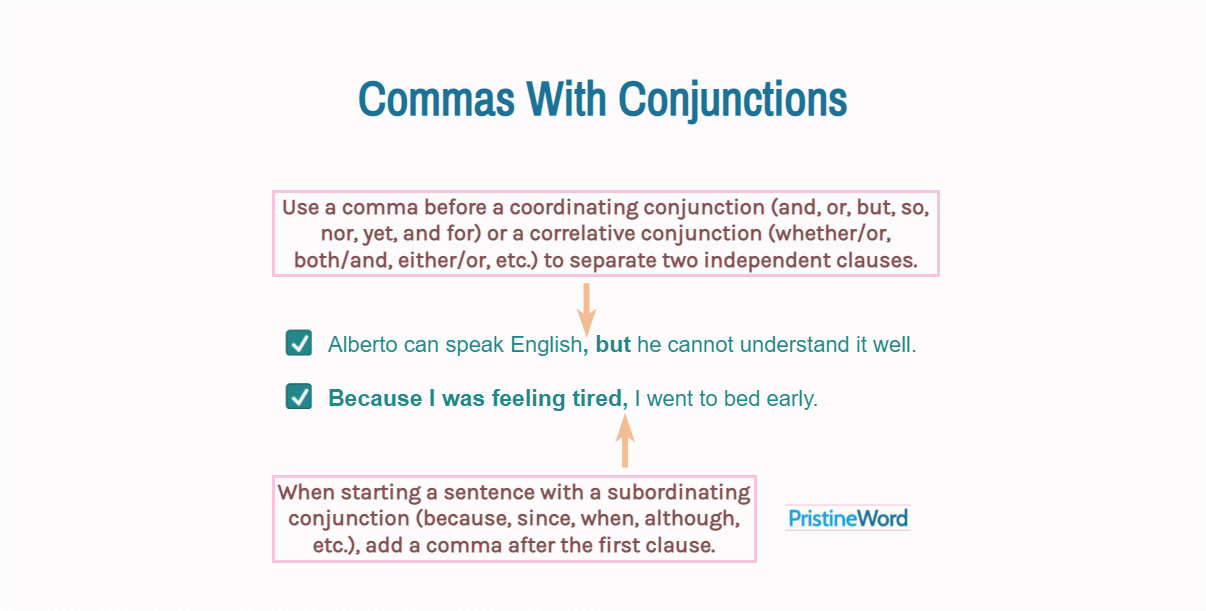Use a comma before a coordinating conjunction or a correlative conjunction to separate two independent clauses.
Use a comma before a coordinating conjunction (and, or, but, so, nor, yet, and for) or a correlative conjunction (whether/or, both/and, either/or, etc.) to separate two independent clauses.
Alberto can speak English, but he cannot understand it well.
Alberto can speak English but he cannot understand it well.
When starting a sentence with a subordinating conjunction (because, since, when, although, etc.), add a comma after the first clause.
Because I was feeling tired, I went to bed early.
Because I was feeling tired I went to bed early.
Contents
1. Types of Conjunctions
There are three types of conjunctions:
- Coordinating conjunctions. These conjunctions join words, phrases, clauses, or sentences of similar structure, significance, or function. There are seven coordinating conjunctions (and, or, but, so, nor, yet, and for).
- Correlative conjunctions. These conjunctions help us express a thought by indicating a correlation between two ideas or concepts. Some common correlative conjunctions are whether/or, both/and, either/or, neither/nor, not only/but also, and rather/than.
- Subordinating conjunctions. Used to join an independent clause to a dependent clause, subordinating conjunctions help us describe a range of connections, including cause-and-effect, space, or time relationships. "Because", "since", "when", "although", "until", "if", and "while" are common subordinating conjunctions.
2. Commas With Coordinating Conjunctions
We place a comma in front of a coordinating conjunction to introduce an independent clause (a group of words with a subject and a verb that can stand alone).
Did John study in England, or did he study in the US?
Did John study in England or did he study in the US?
We can also use a comma before "and" or "or" in a list of three or more items. This comma, also known as the Oxford comma or serial comma, is optional.
I would like to learn Spanish, Italian, or French.
Some writers add a comma before "but" even if the second part of the sentence is a dependent clause or a phrase.
Patricia went to China, but didn't visit the Great Wall.
This is a list of the seven coordinating conjunctions. You can follow their links to learn more about how to use commas with these words.
3. Commas With Correlative Conjunctions
We also use a comma before a correlative conjunction to separate independent clauses.
Not only does Robert speak Chinese, but he speaks Japanese.
If a correlative conjunction joins two dependent clauses, the comma is typically unnecessary.
He enjoys both playing football and watching TV series.
Neither David nor Susan attended the meeting last week.
This is a partial list of correlative conjunctions. Follow their links to find more examples and learn more about how to use commas with them.
4. Commas With Subordinating Conjunctions.
When introducing a sentence with a subordinating conjunction, use a comma to separate both clauses.
Because my wife loves Asian countries, we visited Myanmar last summer.
Because my wife loves Asian countries we visited Myanmar last summer.
Another example:
Although Carol worked hard in the family business, she didn't get any recognition.
In the middle of a sentence, a comma before a subordinating conjunction is generally unnecessary.
Everyone must stay here until my boss comes.
Take care of my brother while I am running a few errands.
This is a partial list of common subordinating conjunctions. You can follow their links to find more examples and learn more about how to use commas with these words:
5. Conclusion
These simple guidelines will help you decide whether to use a comma before or after a conjunction.
- Place a comma before a coordinating or correlative conjunction to separate two independent clauses.
- When starting a sentence with a subordinating conjunction, add a comma after the first clause.

